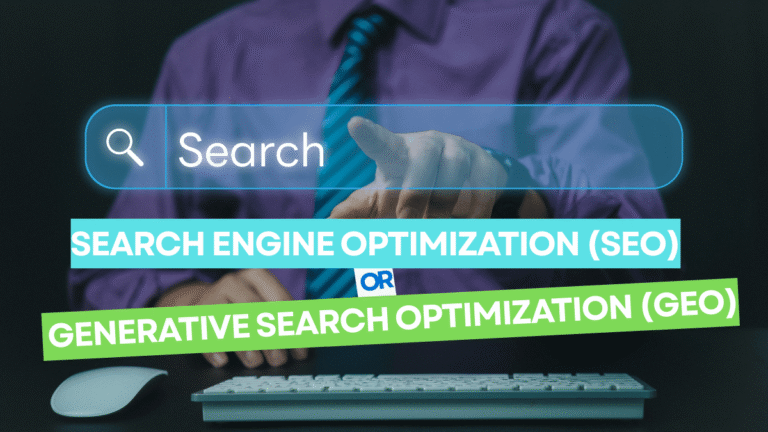You asked AI a question — did it show you a list of links? Probably not. You got a synthesized answer. That shift means ranking in search results no longer guarantees visibility. To be seen in the AI era, marketers must master Generative Engine Optimization (GEO) — the next frontier of content strategy.
What Is Generative Search Optimization (GEO)?
GEO is the practice of crafting content so that generative AI systems like ChatGPT, Google’s AI Overviews, Gemini, or Perplexity select, understand, and cite your content. Zanforth
Traditional SEO aims to rank pages for users to click. GEO aims to embed your content in the answer itself.
From the academic side, GEO was formalized in “GEO: Generative Engine Optimization,” which showed content optimized for AI engines can boost source visibility by up to ~40%.
GEO vs Traditional SEO: What’s the Difference?
| Feature | SEO Approach | GEO Approach |
|---|---|---|
| Goal | Rank in SERPs, get clicks | Be cited and surfaced in AI-generated answers |
| Signals | Keywords, backlinks, page authority | Structured data, entity clarity, authoritative writing, citation friendliness |
| Delivery | Page shown among links | Content appears inside a conversational answer |
| Metrics | Impressions, clicks, rankings | Citation rate in AI answers, inclusion frequency, brand mention quality |
GEO doesn’t replace SEO. It complements it. Modern strategies combine both to maximize visibility across user behaviors. Search Engine People+2OuterBox+2
Why GEO Matters: Stakes & Strategy
For Businesses & Content Operators
- Your competitors will target AI visibility. If you don’t, you may lose the “zero-click” audience.
- GEO can act as a traffic multiplier: being cited in AI answers can drive brand awareness and downstream clicks.
- It forces you to be precise, fact-based, and structured — boosting trust and authority.
For Users & Information Consumers
- Users receive cleaner, context-aware answers from a few trusted sources, not endless links.
- If your brand isn’t in that mix, you lose influence over narrative and perception.
For Investors & Tech Buyers
- SEO as a growth lever weakens; the moat shifts to content engineering, data architecture, and AI visibility.
- Tools, platforms, and agencies that specialize in GEO will gain outsized importance.
How to Add GEO into Your Strategy: Concrete Methods
- Use structured answers / FAQ formats
- Break content into question-answer pairs.
- Use bullet lists, tables, short paragraphs.
- This format helps AI parse and select bits to include.
- Embed authoritative signals
- Cite reputable sources.
- Use numeric data, names, dates, specifics.
- That helps AI systems verify and include your content.
- Optimize entity clarity & context
- Use consistent terminology and naming (persons, products, places).
- Disambiguate via appending clarifiers (e.g. “OpenAI,Gemini, or CoPilot”) so AI can map correctly.
- Maintain topic depth and semantic breadth
- Cover topic clusters, related questions, subtopics.
- Don’t just answer “What is X?” — add edges (How, Why, Future).
- Ensure AI can access your content
- Use clean HTML, semantic markup, schema where applicable.
- Avoid content hidden behind heavy JS, paywalls, or invisible text.
- Use canonical tags wisely.
- Track AI citations & inclusion
- Run queries in ChatGPT, Perplexity, and see if your content is used.
- Use AI-monitoring tools or logs to detect when your pages are cited.
- Use those insights to iterate.
- Create signal-boosting assets
- Publish briefs, domain studies, embed quotes or tables that can act as “snippets.”
- Guest posts, research, third-party references help build the semantic web around your brand.
- Iterate fast
- Because AI systems evolve fast, test, monitor, adjust frequently.
- Some recent studies propose role-augmented intent modeling to better match AI retrieval behavior. arXiv
Key Insights
- GEO is the discipline of making your content visible inside AI-generated answers.
- It extends — not replaces — SEO. Dual optimization wins.
- Structured content, authoritative citations, and semantic clarity matter more than ever.
- You can boost AI citation rates up to ~40% with proper GEO strategies. arXiv
- Measuring success means tracking inclusion, not just clicks.
FAQs About GEO
- Is GEO just rebranded SEO?
No. While related, GEO centers on AI inclusion, not ranking position. - Which platforms use GEO?
ChatGPT, Google AI Overviews, Gemini, Perplexity, Claude, etc. - Is GEO proven or speculative?
It’s emergent. The original GEO paper shows gains up to ~40%. arXiv - Does GEO help in traditional search results too?
Yes — structured, well-written content tends to perform well in both. - How do I know if AI is citing my content?
Test queries, use AI monitoring, or use tools that track LLM citations. - Does GEO require technical skills?
Some — especially in structure, markup, schema, content design. - What kinds of content are easiest to optimize for GEO?
Definitions, comparisons, FAQs, explainers, data summaries work well. - Will GEO replace SEO eventually?
Probably not. They’ll converge. SEO remains key for baseline visibility. - Should I rewrite existing content?
Yes — convert to question/answer format, improve structure, add citations. - How frequent should I update for GEO?
Frequently. AI models update, and content freshness helps. - Are there tools specific to GEO?
A few emerging platforms and analytics services; this space is nascent. - Does GEO favor domain authority?
Yes — authority and trust remain signals for AI systems selecting sources.
The AI shift isn’t coming — it’s here. Start applying GEO now:
- Audit your high-traffic pages and convert them into AI-friendly formats
- Monitor whether AI systems cite your content
- Treat content as infrastructure: build with AI in mind
If you lean early, your brand will sit among the voices the next generation of search uses — not just the ones it links to.


